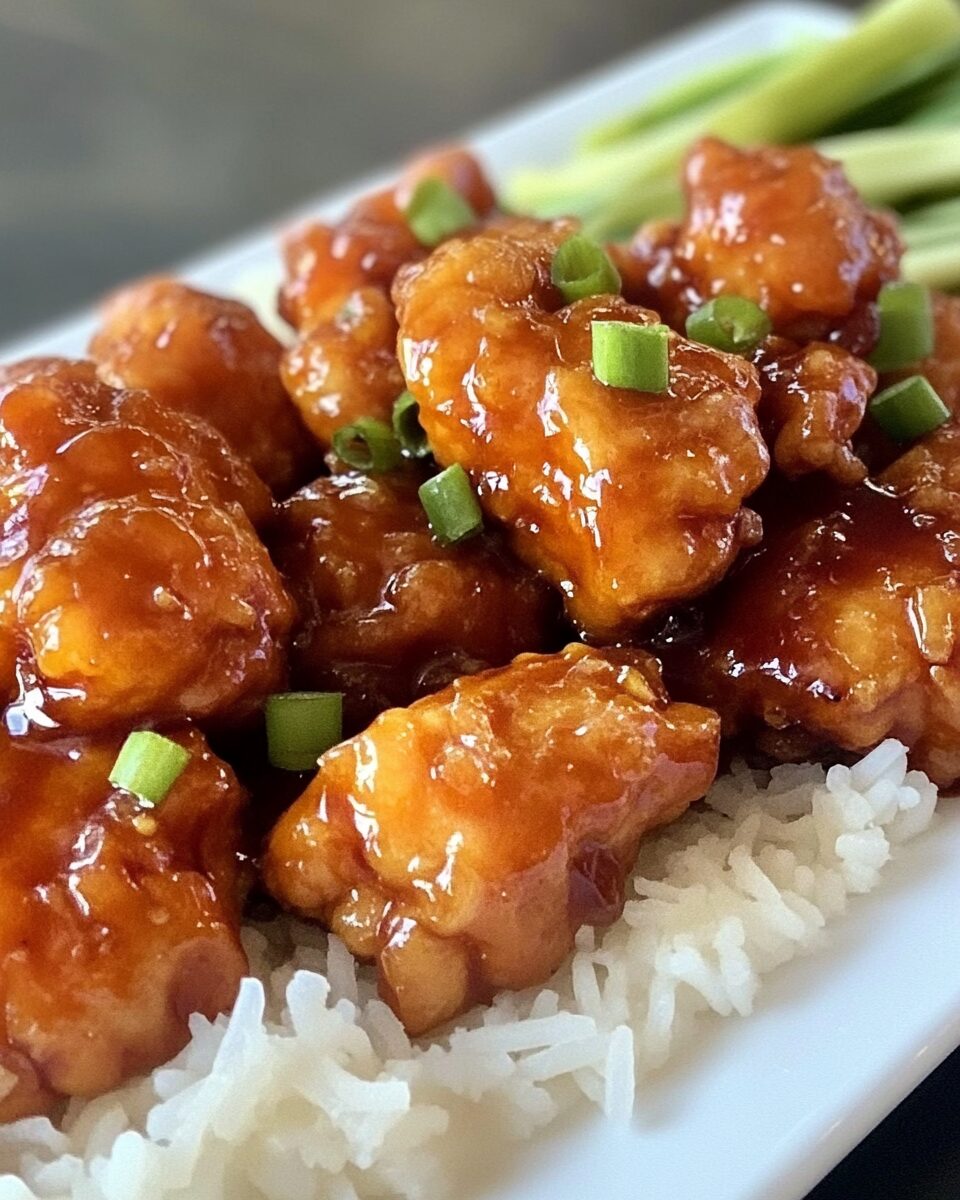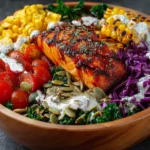This easy Orange Chicken recipe offers a delightful balance of crispy, juicy chicken and a sweet-tangy orange sauce that will tantalize your taste buds. The hint of ginger and garlic adds depth, while the orange zest enhances the citrusy kick.
Perfect for a family dinner or an easy weeknight meal, this dish is a great alternative to takeout. Serve it over fluffy steamed rice or alongside a crisp salad for a complete and satisfying meal. You’ll love how quick and easy it is to make while delivering restaurant-quality flavors right in your kitchen.
Full Recipe:
Ingredients:
- 2 lbs chicken breast, cut into bite-sized pieces
- 1/2 cup cornstarch
- 1/4 cup all-purpose flour
- 2 large eggs, beaten
- 1/2 cup vegetable oil for frying
For the sauce:
- 1/2 cup orange juice
- 1/4 cup soy sauce
- 1/4 cup sugar
- 2 tablespoons rice vinegar
- 1 tablespoon cornstarch mixed with 2 tablespoons water
- 1 teaspoon grated ginger
- 1/2 teaspoon garlic powder
- Zest of 1 orange
Directions:
- In a shallow bowl, mix cornstarch and flour. Coat the chicken pieces in the mixture, then dip into the beaten eggs, and coat again with the cornstarch mixture.
- Heat vegetable oil in a large skillet over medium heat. Fry the chicken pieces until golden and crispy, about 5 minutes per side. Transfer to a paper towel-lined plate to drain.
- In a saucepan, combine orange juice, soy sauce, sugar, rice vinegar, ginger, and garlic powder. Bring to a simmer over medium heat.
- Stir in the cornstarch-water mixture and orange zest. Cook until the sauce thickens, about 2-3 minutes.
- Toss the fried chicken pieces in the sauce until evenly coated.
- Serve hot over steamed rice, garnished with green onions or sesame seeds if desired.
Prep Time: 15 minutes | Cooking Time: 20 minutes | Total Time: 35 minutes
Kcal: 350 kcal | Servings: 4 servings
History and Inspiration Behind Orange Chicken
Orange Chicken is a beloved dish in Chinese-American cuisine, often associated with popular restaurants like Panda Express. While it draws inspiration from traditional Chinese sweet and sour dishes, Orange Chicken is a distinctly American creation. Its hallmark lies in the perfect balance of crispy fried chicken paired with a sweet, tangy, and slightly sticky orange glaze.
This recipe simplifies the process, making it approachable for home cooks while maintaining its restaurant-quality appeal. By using fresh orange juice and zest, it elevates the dish’s natural citrus flavors, making it both vibrant and aromatic.
Tips for Perfect Orange Chicken
- Chicken Prep: Use boneless, skinless chicken breast or thighs for the best texture. Thighs tend to stay juicier, while breasts offer a leaner option.
- Frying Technique: To achieve a crisp coating, ensure the oil is heated to around 350°F (175°C) before frying. This helps the coating crisp up quickly without absorbing excess oil.
- Homemade Sauce: Fresh orange juice and zest are key for a bright, authentic flavor. Adjust the sweetness by adding more or less sugar based on your taste preferences.
- Thickening the Sauce: The cornstarch slurry (cornstarch mixed with water) ensures the sauce clings perfectly to the chicken. Stir constantly when adding it to avoid lumps.
- Serving Suggestions: Pair the Orange Chicken with steamed jasmine rice or fried rice for a classic combination. Alternatively, serve it alongside steamed vegetables like broccoli or bok choy for a healthier twist.
Variations and Customizations
- Spicy Kick: Add red pepper flakes or a splash of sriracha to the sauce for a spicy version.
- Lighter Option: Instead of frying, bake the chicken pieces in the oven at 400°F (200°C) for 20-25 minutes, turning halfway.
- Vegetarian Version: Substitute chicken with tofu or cauliflower florets. Coat and fry them the same way for a plant-based alternative.
- Gluten-Free Adaptation: Use gluten-free soy sauce and swap all-purpose flour for gluten-free flour to make this dish gluten-free.
Nutritional Benefits of Homemade Orange Chicken
Making Orange Chicken at home allows you to control the ingredients and tailor the dish to your preferences. You can:
- Use less sugar for a lighter sauce.
- Fry with healthier oils or bake for a lower-calorie version.
- Avoid additives or preservatives found in some store-bought or takeout versions.
Each serving provides a satisfying blend of protein and vibrant flavors, making it a wholesome choice when paired with nutrient-rich sides like vegetables or whole grains.
Fun Facts About Orange Chicken
- Orange Chicken became widely popular in the U.S. during the 1980s and is now a staple on many Chinese-American restaurant menus.
- The dish has inspired many creative versions, including Orange Chicken tacos, pizza, and even burritos!
- In its home-cooked form, it allows endless versatility, letting you experiment with sauces, proteins, and sides.
The Origin of Orange Chicken
Orange Chicken has roots in Chinese-American cuisine, blending traditional Chinese cooking techniques with flavors tailored to Western palates. This dish was inspired by Hunan and Sichuan-style Chinese recipes that combine sweet and savory elements. However, the orange glaze as we know it today is a modern twist, emphasizing sweetness and citrusy notes. It gained widespread popularity in the United States through restaurants like Panda Express, cementing its place as a comfort food favorite.
Why Make Orange Chicken at Home?
Cooking Orange Chicken at home offers several advantages:
- Customizable Flavors: Adjust the sweetness, tanginess, or spice level according to your taste preferences.
- Fresher Ingredients: Use fresh orange juice and zest for a more vibrant and natural flavor compared to store-bought sauces.
- Healthier Alternative: Avoid excess sodium, artificial preservatives, and added sugars commonly found in restaurant versions.
- Budget-Friendly: Making this dish at home is significantly cheaper than ordering takeout, especially when serving a family.
Cooking Tips for Success
- Achieving the Perfect Crunch:
- Pat the chicken pieces dry before coating them in cornstarch and flour. This helps the coating stick better and ensures a crispy texture.
- Fry the chicken in batches to avoid overcrowding the pan, which can lower the oil temperature and result in soggy chicken.
- Balancing the Sauce:
- Taste the sauce as it cooks and adjust the sugar or soy sauce to strike the perfect balance of sweetness and saltiness.
- For an extra layer of flavor, a dash of sesame oil can be added to the sauce just before tossing it with the chicken.
- Make It Ahead:
- Prep and fry the chicken in advance, then reheat it in the oven at 375°F (190°C) for 10-15 minutes to restore its crispiness.
- The sauce can also be prepared ahead of time and stored in the fridge for up to 3 days. Reheat gently before serving.
Serving Ideas
- Classic Pairing: Serve over steamed jasmine or basmati rice for a comforting, hearty meal.
- Vegetable Sides: Pair with stir-fried green beans, steamed broccoli, or a fresh cucumber salad to add more balance to your plate.
- Noodle Option: Toss the Orange Chicken with cooked lo mein noodles or rice noodles for a fun twist.
Fun Ways to Elevate the Recipe
- Garnishes: Sprinkle with toasted sesame seeds and finely chopped green onions for an authentic restaurant-style presentation.
- Citrus Boost: Add a splash of fresh lemon or lime juice for a tangier kick.
- Spicy Twist: Mix in chili flakes or drizzle with sriracha for a spicy variation.
- Asian Fusion: Serve with egg rolls, potstickers, or spring rolls for a complete Asian-inspired feast.
Healthier Substitutions
- Air-Frying Instead of Deep-Frying: Use an air fryer to cook the chicken for a crispy texture without excess oil.
- Low-Sodium Soy Sauce: Swap regular soy sauce with low-sodium soy sauce to reduce the sodium content.
- Honey or Maple Syrup: Replace sugar with honey or maple syrup for a natural sweetener option.
Did You Know?
- Orange Chicken’s sweet and tangy sauce pairs exceptionally well with other proteins like shrimp or tofu, making it versatile for different dietary preferences.
- Leftover Orange Chicken can be transformed into a fried rice dish by stir-frying it with day-old rice, scrambled eggs, and vegetables.






